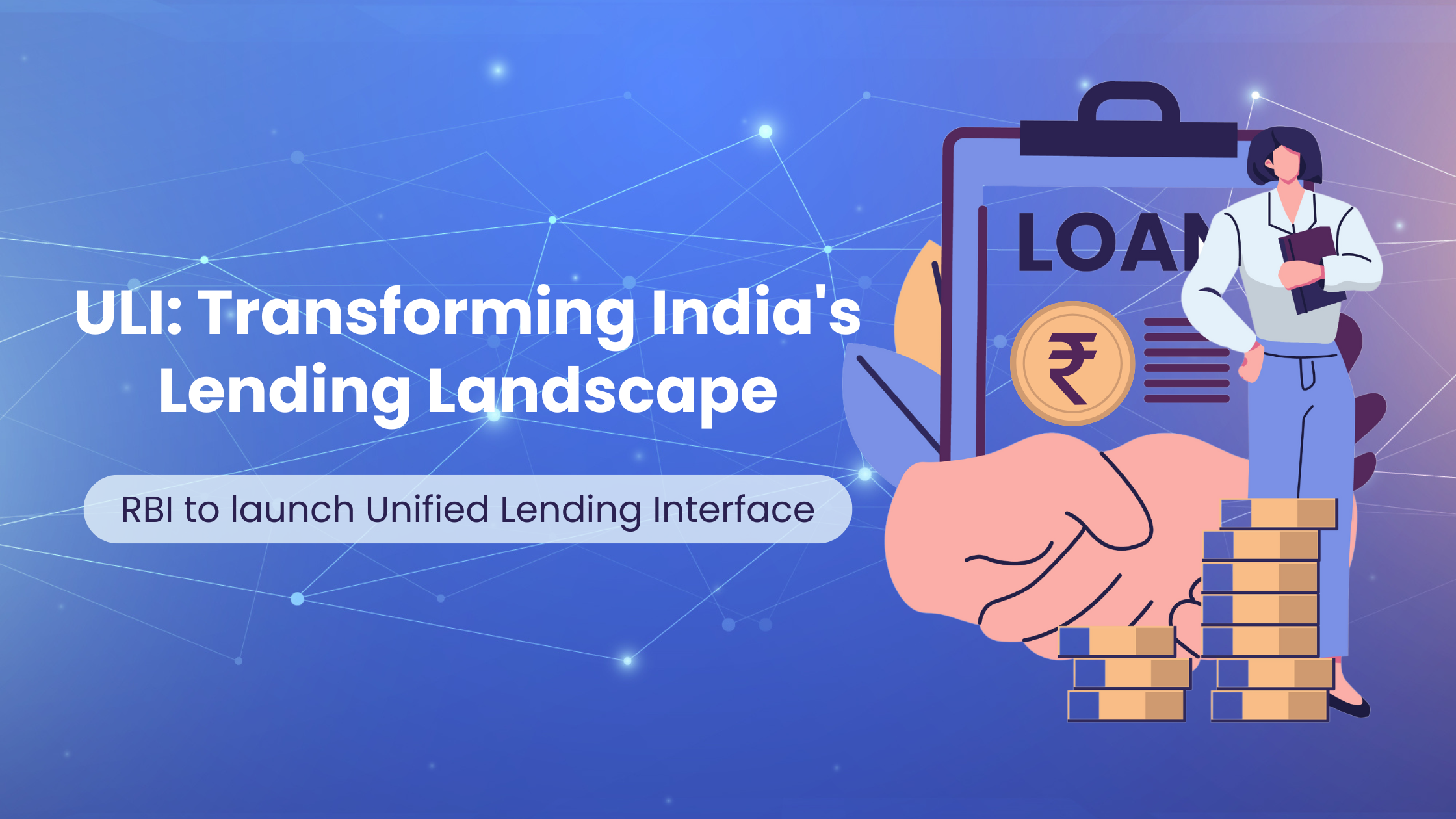India is set to transform the way people avail loans from banks and other non-banking financial services companies. The Reserve Bank of India (RBI) has launched a new path-breaking platform – Unified Lending Interface (ULI). This new platform could tremendously improve the access to loans / credit from the formal financial services for millions of people in India. Much like how the Unified Payments Interface (UPI) revolutionized payments and digital transactions, ULI aims to bring about a transformative shift in how credit is accessed, especially by those in rural and underserved areas. This initiative is not just about improving financial inclusion—it’s about redefining the future of finance in India, making it more inclusive, transparent, and efficient.
What is the Unified Lending Interface (ULI)?
The Unified Lending Interface (ULI) is a digital platform developed by the RBI to streamline and digitize the lending process in India. Designed to mimic the success of UPI in the payments sector, ULI centralizes and simplifies access to credit, allowing borrowers to connect with multiple lenders on a single platform. This system is particularly beneficial for individuals and micro, small, and medium enterprises (MSMEs) in rural areas, who have traditionally faced significant barriers in obtaining easy access to credit.
Objectives of ULI
Simplified Lending Process: By integrating various lenders into one platform, ULI makes it easier for borrowers to compare loan offers and choose the most suitable option.
Enhanced Transparency: ULI reduces turnaround times and enhances transparency in loan disbursements, ensuring a more efficient process.
Key Features of ULI
Digital Platform: ULI digitizes the entire lending process, making it accessible even to small and rural borrowers. The platform’s digital nature eliminates traditional barriers and enhances the efficiency of lending.
Centralized Database: ULI’s robust centralized database consolidates comprehensive financial and non-financial data. ULI integrates data from diverse sources like Aadhaar, e-KYC, PAN databases, land records, cattle, milk production, credit scores, details of bank accounts, and repayment-related information of borrowers. Integrating data from state-level databases, such as agricultural databases or industrial registries, could provide more specific information relevant to different sectors. This nationwide platform ensures that lenders can access critical borrower information in real-time, leading to faster and more informed lending decisions. This centralized system is particularly beneficial for sectors like agriculture and MSMEs, where timely access to data is crucial for meeting credit demands.
Consent-Based Data Access: The ULI platform operates on a consent-based system, providing lenders with secure digital access to borrowers’ financial and non-financial information, including land records. This approach ensures data privacy and empowers borrowers by giving them control over who accesses their information.
Standardized API Integration: ULI offers a set of standardized Application Programming Interfaces (APIs) designed for simplicity and ease of use. These common APIs support a ‘plug-and-play model, drastically reducing the technical complexities typically associated with integrating new systems. Lenders can effortlessly access the data they need, enabling quicker deployment of credit solutions and reducing operational overheads.
Why ULI matters: The need for change in the lending landscape
India’s current lending ecosystem, though robust, is often fragmented and inaccessible, particularly to the rural people. Traditional banks have stringent, time-consuming, and complex credit appraisal processes, making it difficult for small businesses and individuals without a credit history to obtain loans. ULI addresses these issues by providing a unified platform that reduces the need for extensive paperwork and prolonged waiting periods. By doing so, ULI democratizes access to credit, making it easier for underserved populations to secure loans for personal or business needs.
For MSMEs, which are the backbone of the Indian economy, timely access to credit is crucial. ULI could significantly reduce the credit gap faced by these enterprises, facilitating quicker and more efficient access to funds.
How does the ULI work?
ULI revolutionizes the credit appraisal process by enabling the seamless digital flow of land records from various States directly to lenders. This drastically reduces appraisal times, particularly for MSMEs and rural borrowers. Built on an API-driven architecture, ULI employs standardized, plug-and-play interfaces to access diverse data sources, ensuring quick and efficient credit delivery with minimal documentation. This means borrowers can access financial services faster and more easily than ever before.
Benefits of the Unified Lending Interface (ULI)
The ULI promises several benefits for both borrowers and lenders, potentially transforming the lending landscape in India.
1.Increased Access to Credit: ULI makes it easier for individuals and businesses, especially in rural and underserved areas, to access credit. By bringing multiple lenders onto a single platform, it increases competition and provides borrowers with more options.
2. Reduced Processing Time: Traditional loan processing can take weeks or even months. With ULI, the process is expected to be much faster, with approvals potentially happening within minutes or hours due to the use of technology and automation.
3. Transparency and Fairness: ULI enhances transparency by allowing borrowers to compare loan offers from multiple lenders, promoting fair competition and potentially leading to better interest rates and terms.
4. Lower Costs: By reducing the need for physical branches and manual processing, ULI could lower operational costs for lenders. These savings could be passed on to borrowers in the form of lower interest rates or reduced fees.
5. Enhanced Financial Inclusion: ULI’s most significant benefit is its potential to enhance financial inclusion by making credit more accessible to marginalized and underserved communities, helping to bridge the financial divide in India. As part of the digital ecosystem that includes Jan Dhan, Aadhaar, and UPI, ULI will be a key player in India’s push for greater financial inclusion.
Recommended Read: Why the rise in unsecured credit is a concern for the RBI
Challenges and Considerations
While ULI holds great promise, several challenges must be addressed for its successful implementation:
1. Managing Lending Risks: Unlike UPI, which facilitates payments, ULI involves direct credit facilitation, making lenders responsible for loan recovery. Effective strategies are needed to manage these risks without compromising ULI’s efficiency.
2. Repayment Risks: The introduction of ULI brings new risks, especially for small borrowers who may struggle to repay loans during economic downturns. Lenders must be aware of these risks and plan accordingly.
3. Data Privacy and Security: ULI will handle vast amounts of personal and financial data, making robust data privacy and security measures essential. The platform must adhere to data protection laws to safeguard borrower information.
4. Digital Literacy: For ULI to succeed, particularly in rural areas, borrowers need to understand how to use the platform. Efforts must be made to improve digital literacy among these users.
The road ahead: ULI’s potential impact on India’s economy
The launch of the Unified Lending Interface represents a monumental step forward in India’s journey toward becoming a digitally empowered society. By making credit more accessible, transparent, and efficient, ULI has the potential to unlock new opportunities in sectors such as agriculture and MSMEs. Easier access to credit will allow small and rural borrowers to invest in expansion, innovation, and job creation, driving economic growth and development.
Conclusion: Shaping the future of finance in India
The Unified Lending Interface is set to revolutionize the lending landscape in India. As the RBI and other stakeholders work toward its implementation, ULI could soon become an indispensable tool for financial inclusion and economic empowerment. By bridging the gap between borrowers and lenders, ULI has the potential to reshape the future of finance in India, making it more accessible, transparent, and efficient for all.
FAQs
1. What is the Unified Lending Interface (ULI)?
The Unified Lending Interface (ULI) is a digital platform initiated by the Reserve Bank of India (RBI) to make borrowing money easier and faster, especially for small businesses, farmers, and rural communities.
2. Who benefits most from ULI?
Small businesses, farmers, and people in rural areas will benefit the most from ULI, as it helps them get loans more easily and quickly.
3. How is ULI different from UPI?
ULI is focused on making the process of getting loans easier, while UPI (Unified Payments Interface) is designed for quick and simple digital payments. ULI handles the more complex steps of lending, such as risk assessment and approval.
4. What are the challenges for ULI?
ULI faces challenges like protecting data privacy, ensuring accurate loan risk assessments even with faster processing, and increasing user adoption among people and banks. Overcoming these challenges is key to ULI’s success.






